Invasive Phragmites
Image credit: Joseph McCauley, US Fish and Wildlife Service, Bugwood.org
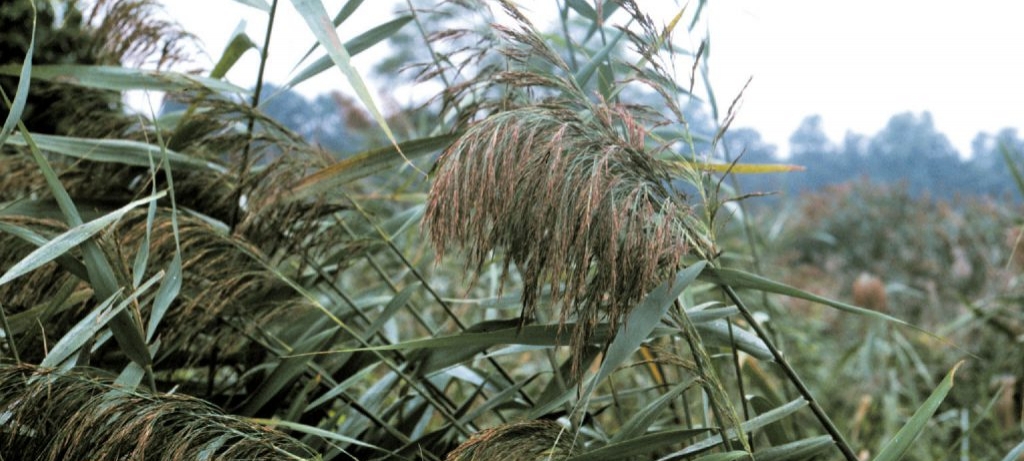
Invasive Phragmites
Image credit: Joseph McCauley, US Fish and Wildlife Service, Bugwood.org
Found throughout the United States, Phragmites australis is yet another invasive that plagues the Great Lakes region. It should be known that there is a native subspecies of phragmites found in Michigan, Phragmites australis subsp. americanus, which is often confused with its invasive counterpart. Although invasive phragmites infestations in the Upper Peninsula are primarily concentrated along the northern shore of Lake Michigan, there have been a few isolated sightings in the Keweenaw, and these sightings may grow in number as the surveying for this species increases. This grass invader grows readily in wetlands, ditches, swales, and along stream and pond banks. Common identifying features include:
As previously mentioned, native phragmites is often confused as an invasive, and as a result, many have unknowingly removed native stands. In order to avoid this, look for the distinguishing characteristics between the two. Invasive phragmites often have leaves that appear grayish or bluish-green compared to the native species which appear green to light green in color. Furthermore, the stems of invasive phragmites are typically a dull greenish-tan color, whereas native stems often display a reddish or purplish tone.
For more information, visit the Midwest Invasive Species Information Network (MISIN) or the Great Lakes Phragmites Collaborative.
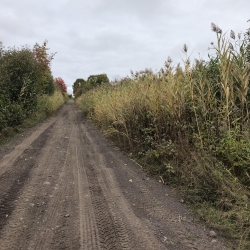
Phragmites along a roadside, notice their feather-like flowers
Image credit: Sigrid Resh
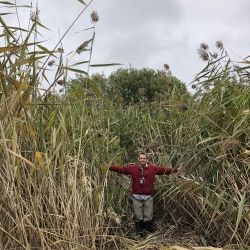
Invasive phragmites will form dense monocultures
Image credit: Sigrid Resh
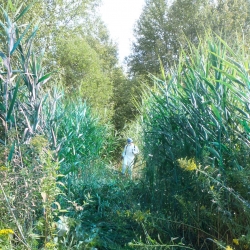
Another large infestation of phragmites, notice the bluish hue distinct to the leaves of invasive phragmites
Image credit: Ian Shackleford
Phragmites can quickly spread through Keweenaw marshes and wetland areas, robbing fish, plants, and wildlife of nutrients and space; blocking access to the water for recreational purposes; ruining shoreline views; and posing a fire hazard through the accumulation of dead stalks. The plant is also able to adjust its growth based on environmental conditions and survive stagnant, oxygen poor, or salty conditions. Phragmites is spread by wind-borne or animal-borne seeds, or through intentional introduction. More commonly, Phragmites spreads through above ground root structures called stolons or through its underground rhizomes. Due to its (not so) great ability to establish a site and form dense monocultures, phragmites management can often prove difficult and costly. See the following steps and this guide to phragmites management:
Note: It is unlikely and unrealistic for the average person to perform widespread chemical and mechanical management of phragmites. The best thing to do is to consistently monitor your local area for new signs of invasion in order to address the problem before the plant fully establishes a population. If you do happen to come across such a site, reach out to your local invasive species management group which will have the proper resources and connections to properly handle the invasion.
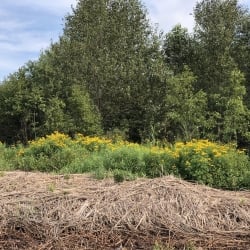
Dead phragmites after treatment
Image credit: Sigrid Resh
If you do happen to remove invasive phragmites on your property, it would be a good idea to plant natives in its absence. The appropriate native replacements depend on the type of wetland, but native willow (Salix spp.), red-osier dogwood (Cornus sericea), and sweet gale (Myrica gale) are good options as well as other native wetland grasses and reeds.